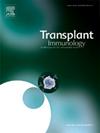Case report: Recipient-derived, late-onset post-transplant lymphoproliferative disorder involving a transplanted liver
IF 1.4
4区 医学
Q4 IMMUNOLOGY
引用次数: 0
Abstract
Introduction
Post-transplant lymphoproliferative disorders (PTLD) are severe complications of transplantation associated with poor outcomes. Compared to early-onset PTLDs, late-onset PTLDs are much less associated with allograft localization. Herein, we report a case of Epstein-Barr virus (EBV)-negative lymphoma involving a graft 7 years after liver transplantation.
Case presentation
A 45-year-old man presented with hepatomegaly 7 years after liver transplantation. Liver puncture biopsy revealed B-cell lymphoma with a high proliferation index and a germinal center B-cell-like subtype. Tissue and other donor information were unavailable. Next-generation sequencing was performed on the tumor and recipient tissues, and the single nucleotide polymorphism (SNP) sites were identical, thereby confirming the recipient origin. The patient received a reduction in immunosuppression and six cycles of rituximab, reduced doses of cyclophosphamide, doxorubicin, vincristine, and prednisone, and achieved complete remission after the fourth cycle of treatment. The patient remained in good condition for 7 months after the last chemotherapy dose.
Conclusion
This rare case report describes a late-onset EBV-negative recipient-derived PTLD involving a transplanted liver. SNP analysis is a useful method for determining tumor origin in situations where donor tissue is unavailable.
病例报告:受者来源,移植后迟发性淋巴细胞增生性疾病累及移植肝脏。
移植后淋巴细胞增生性疾病(PTLD)是移植术后的严重并发症,预后较差。与早发性PTLDs相比,晚发性PTLDs与同种异体移植物定位的相关性要小得多。在此,我们报告一例eb病毒(EBV)阴性淋巴瘤,涉及肝移植7 年后的移植物。病例介绍:45岁男性,肝移植后7 年出现肝肿大。肝脏穿刺活检显示高增殖指数的b细胞淋巴瘤和生发中心b细胞样亚型。无法获得组织和其他捐赠者的信息。对肿瘤和受体组织进行新一代测序,单核苷酸多态性(SNP)位点相同,从而确认受体来源。患者接受了免疫抑制的减少和6个周期的利妥昔单抗,减少了环磷酰胺、阿霉素、长春新碱和强的松的剂量,并在第4个周期的治疗后完全缓解。在最后一次化疗后,患者保持良好状态7 个月。结论:这个罕见的病例报告描述了一个迟发性ebv阴性受体与PTLD累及肝脏移植。在供体组织不可用的情况下,SNP分析是确定肿瘤起源的有用方法。
本文章由计算机程序翻译,如有差异,请以英文原文为准。
求助全文
约1分钟内获得全文
求助全文
来源期刊

Transplant immunology
医学-免疫学
CiteScore
2.10
自引率
13.30%
发文量
198
审稿时长
48 days
期刊介绍:
Transplant Immunology will publish up-to-date information on all aspects of the broad field it encompasses. The journal will be directed at (basic) scientists, tissue typers, transplant physicians and surgeons, and research and data on all immunological aspects of organ-, tissue- and (haematopoietic) stem cell transplantation are of potential interest to the readers of Transplant Immunology. Original papers, Review articles and Hypotheses will be considered for publication and submitted manuscripts will be rapidly peer-reviewed and published. They will be judged on the basis of scientific merit, originality, timeliness and quality.
 求助内容:
求助内容: 应助结果提醒方式:
应助结果提醒方式:


